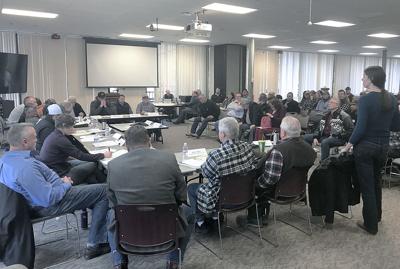https://www.capitalpress.com/ag_sectors/water/scaled-back-klamath-groundwater-regulation-debated/article_8e22ab30-23fb-11e9-951c-33070f078fa7.html
 Scaled-back
Klamath groundwater regulation debated Scaled-back
Klamath groundwater regulation debated
<
The Oregon Water Resources Department organized a meeting in
Klamath Falls on Jan. 28 to discuss a proposed change to
groundwater rules.
KLAMATH FALLS, Ore. — Oregon water regulators may scale back the
number of wells subject to pumping shutdowns in the Upper
Klamath Basin but some irrigators remain uneasy about the
proposal.
Under existing rules, groundwater irrigators within one mile of
surface waters can be “regulated off” by senior water users who
claim the wells are affecting their water rights.
The Oregon Water Resources Department is now considering a
change to the rules, which would limit regulation to wells
within 500 feet of surface waters in the basin, effectively
reducing the number of wells subject to shutdowns from 140 to
seven.
The agency expects to finalize the interim rules in mid-April
until more permanent regulations are enacted in 2021 “so the bar
quits moving for people down here,” said Ivan Gall,
administrator of OWRD’s field services division.
Several irrigators in the Upper Klamath basin have filed
lawsuits challenging the OWRD’s shutdown of their wells in
recent years, alleging the agency didn’t have adequate proof
that groundwater pumping was reducing flows in waterways.
Litigation costs over Klamath Basin water disputes ended up
exceeding the agency’s legal budget in the 2017-2019 biennium,
prompting OWRD to ask lawmakers for additional funds.
While the agency doesn’t relish such legal battles, they can be
a “necessary means to an end,” Gall said during a Jan. 28
meeting about the rules in Klamath Falls, Ore.
“We are not trying to do this interim rule process to avoid
litigation costs,” he said, noting that the proposed rules are
intended to provide OWRD with more time to study water
management and well regulation.
Several irrigators who sit on the agency’s “rules advisory
committee” for the proposal said they appreciate that the
regulatory reach was cut from one mile to within 500 feet of
surface water, but they’re still disappointed with certain
aspects of the interim rules.
Specifically, irrigators said they’re unhappy with the
presumption that wells within that distance will necessarily
affect surface waters, as well as OWRD’s conclusion that
groundwater and surface waters were hydrologically connected
throughout the basin.
“We still don’t like your editorializing on science,” said Roger
Nicholson, an irrigator on the committee. “We don’t think
non-peer-reviewed science has any room in the temporary rule.”
Tom Mallams, who represented the Oregon Cattlemen’s Association
on the committee, said the agency’s statement about the
connection between ground and surface waters was unproven and
“erroneous.”
“It’s a slap in the face for everyone in the Klamath Basin,” he
said, adding that OWRD’s reasoning could be applied to basins
elsewhere in the state.
The agency should have relied more on the expertise and data of
private sector specialists in hydrology, Mallams said. “It
appears they were totally ignored.”
Bruce Topham, a groundwater user on the committee, said it’s
unreasonable to require irrigators whose wells are within 500
feet of surface waters to demonstrate they’re not reducing
stream flows.
“That’s the equivalent of guilty until proven innocent,” he
said. “They’ve asked us to prove a negative and you can’t do
that.”
Gall, of OWRD, said that a hydrologic connection exists if water
can move between groundwater aquifers and surface waters, unless
it’s blocked by an impermeable barrier — which the agency has
been unable to find in the region.
The geology of the basin contains large fault blocks of rock
that tend to be permeable and allow water deep under ground to
discharge into surface waters, Gall said.
During public comments, one participant criticized the OWRD for
being quick to compromise with irrigation interests and
assembling a rules advisory committee that’s designed to “crowd
out the tribal voice.”
Don Gentry, tribal chairman of the Klamath Tribes, said courts
have affirmed that tribal water rights date back to time
immemorial and they need to be protected.
In the past, water calls by the Klamath Tribes have resulted in
OWRD requiring junior water rights holders to stop irrigating.
“We sometimes feel like the lone ranger or the enemy in the
community, but we have senior water rights,” Gentry said.
====================================================
In accordance with Title 17 U.S.C.
section 107, any copyrighted material
herein is distributed without profit or
payment to those who have expressed a
prior interest in receiving this
information for non-profit research and
educational purposes only. For more
information go to:
http://www.law.cornell.edu/uscode/17/107.shtml |

